AMD A10-7800 Review: Testing the A10 65W Kaveri
by Ian Cutress on July 31, 2014 8:00 AM ESTCPU Benchmarks
The dynamics of CPU Turbo modes, both Intel and AMD, can cause concern during environments with a variable threaded workload. There is also an added issue of the motherboard remaining consistent, depending on how the motherboard manufacturer wants to add in their own boosting technologies over the ones that Intel would prefer they used. In order to remain consistent, we implement an OS-level unique high performance mode on all the CPUs we test which should override any motherboard manufacturer performance mode.
HandBrake v0.9.9: link
For HandBrake, we take two videos (a 2h20 640x266 DVD rip and a 10min double UHD 3840x4320 animation short) and convert them to x264 format in an MP4 container. Results are given in terms of the frames per second processed, and HandBrake uses as many threads as possible.
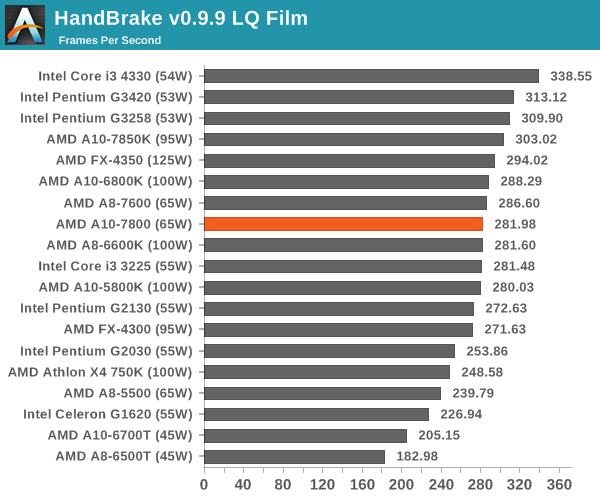
The latest Intel processors have the lead for low quality Handbrake conversion, and despite the generational gap between the FX-4350 and the A10-7800, the extra MHz is preferred here.

For large frame manipulation, the latest architectures mixed with the most threads perform best.
Agisoft Photoscan – 2D to 3D Image Manipulation: link
Agisoft Photoscan creates 3D models from 2D images, a process which is very computationally expensive. The algorithm is split into four distinct phases, and different phases of the model reconstruction require either fast memory, fast IPC, more cores, or even OpenCL compute devices to hand. Agisoft supplied us with a special version of the software to script the process, where we take 50 images of a stately home and convert it into a medium quality model. This benchmark typically takes around 15-20 minutes on a high end PC on the CPU alone, with GPUs reducing the time.
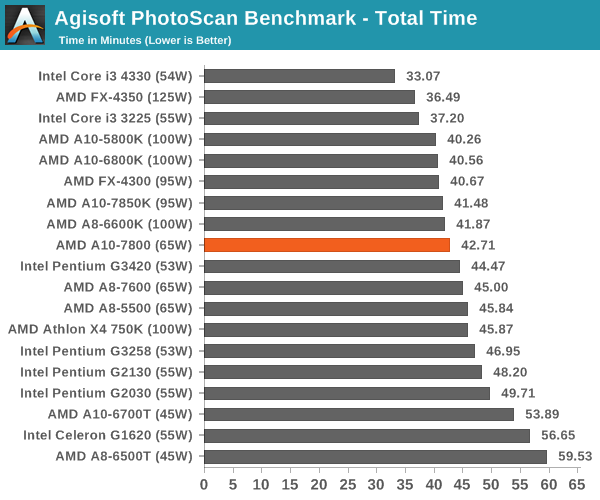
Dolphin Benchmark: link
Many emulators are often bound by single thread CPU performance, and general reports tended to suggest that Haswell provided a significant boost to emulator performance. This benchmark runs a Wii program that raytraces a complex 3D scene inside the Dolphin Wii emulator. Performance on this benchmark is a good proxy of the speed of Dolphin CPU emulation, which is an intensive single core task using most aspects of a CPU. Results are given in minutes, where the Wii itself scores 17.53 minutes.
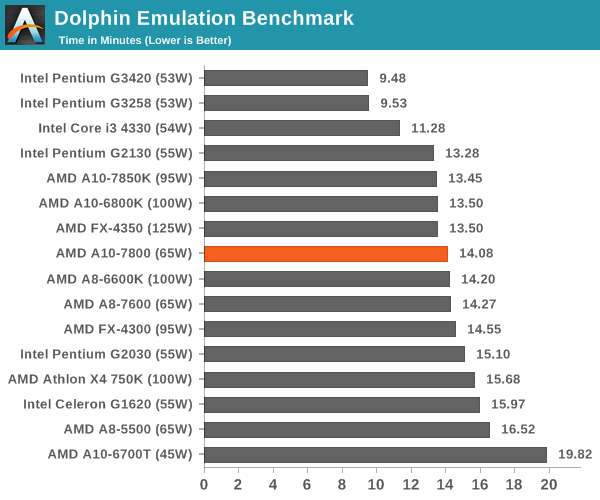
Dolphin seems to work best with high single core speed and Haswell.
WinRAR 5.0.1: link
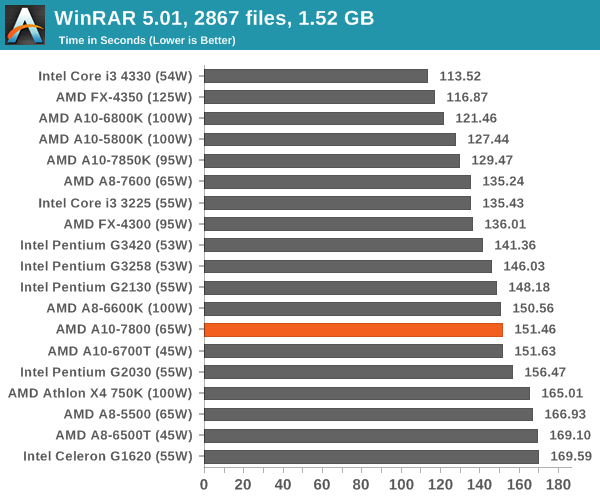
PCMark8 v2 OpenCL on IGP
A new addition to our CPU testing suite is PCMark8 v2, where we test the Work 2.0 and Creative 3.0 suites in OpenCL mode. As this test is new, we have not run it on many AMD systems yet and will do so as soon as we can.
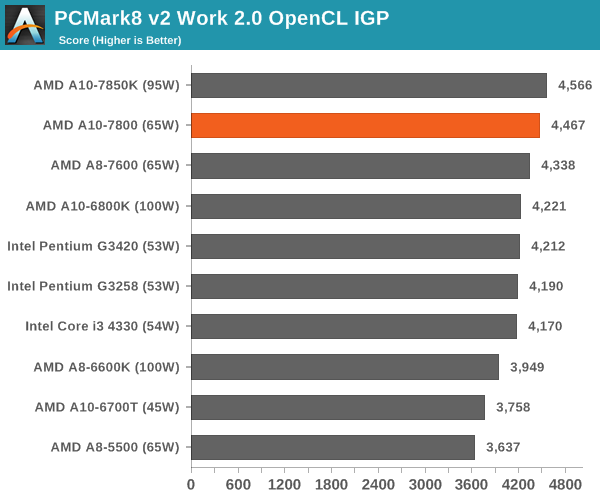
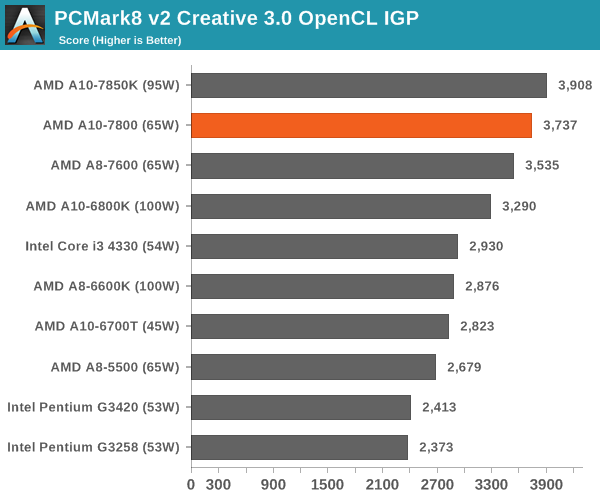
The combination of processor graphics and OpenCL support push the AMD APUs up to the top of our PCMark tests.
Hybrid x265
Hybrid is a new benchmark, where we take a 4K 1500 frame video and convert it into an x265 format without audio. Results are given in frames per second.
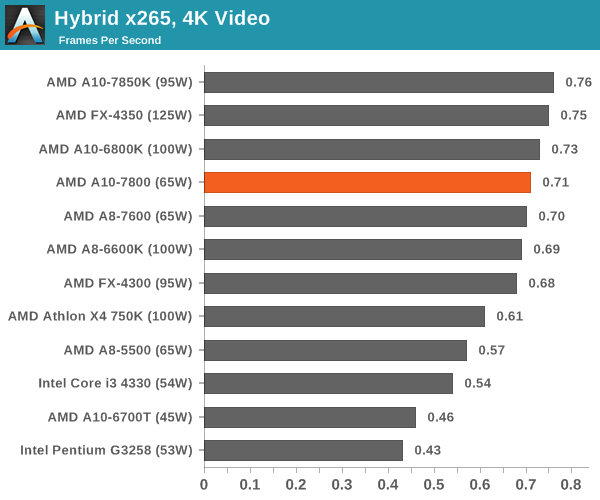
Cinebench R15


Cinebench is typically Intel territory for high IPC processors, but when it comes to multithreaded rendering, extra threads help.
3D Particle Movement
3DPM is a self-penned benchmark, taking basic 3D movement algorithms used in Brownian Motion simulations and testing them for speed. High floating point performance, MHz and IPC wins in the single thread version, whereas the multithread version has to handle the threads and loves more cores.
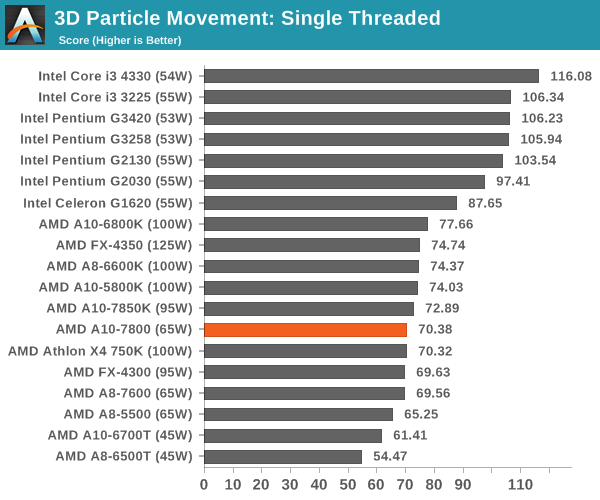
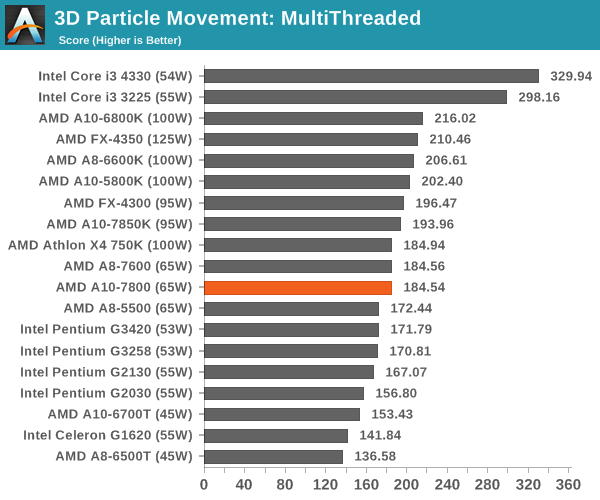
All the calculations in 3DPM deal with floating point numbers, a known sink for AMD compute.
FastStone Image Viewer 4.9
FastStone is the program I use to perform quick or bulk actions on images, such as resizing, adjusting for color and cropping. In our test we take a series of 170 images in various sizes and formats and convert them all into 640x480 .gif files, maintaining the aspect ratio. FastStone does not use multithreading for this test, and results are given in seconds.
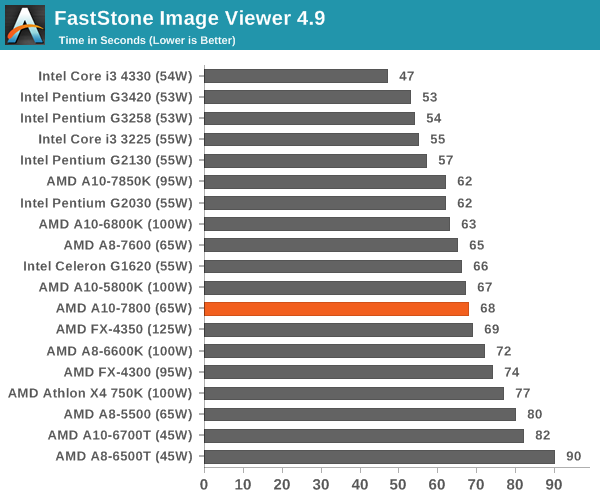
Web Benchmarks
On the lower end processors, general usability is a big factor of experience, especially as we move into the HTML5 era of web browsing. For our web benchmarks, we take four well known tests with Chrome 35 as a consistent browser.
Sunspider 1.0.2

Mozilla Kraken 1.1
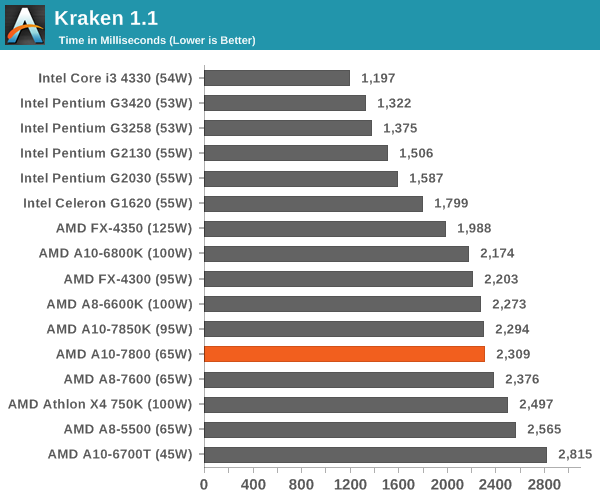
WebXPRT
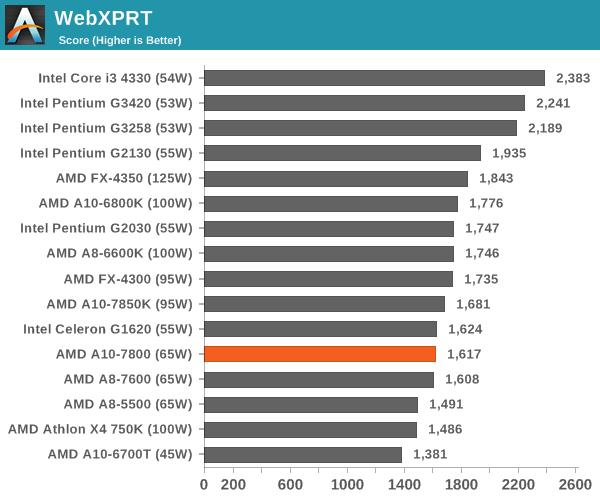
Google Octane v2
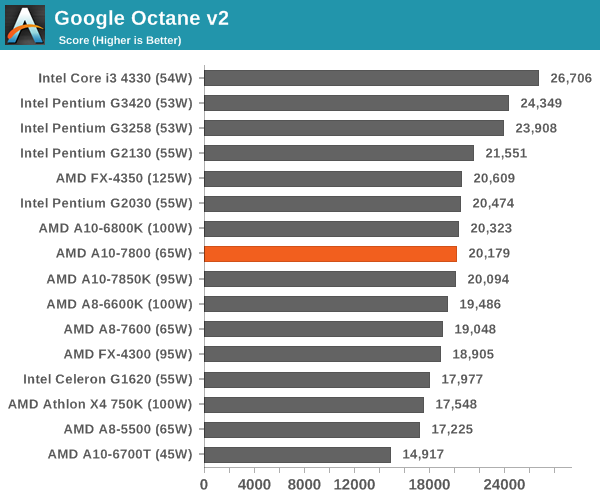










147 Comments
View All Comments
vision33r - Monday, August 4, 2014 - link
This APU seems like 6-7 yrs late. I don't think it's competitive at all and even Intel's newly released SOC meant for mobile will catch and beat AMD APU in less than 2 years. They need to get their chip design competitive fast or soon ARM SOCs will take over the low price desktop market. I think Chromebooks are already outselling AMD notebooks.rooh - Tuesday, August 5, 2014 - link
Good review. I'll buy a laptop with that APU or any with quad-core @2.5GHz or higherSince they play good 1280 * 1024 with lot of total pixels compared to 1366 * 768
They are way 2 good for games at 1366 * 768 resolution as most laptop with them are at that resolution.
2 months from now I will grab mine
Wowhw - Tuesday, August 5, 2014 - link
Most of You need to move to an area where electricity costs 0/per kWh.Seriously. Compaling over TDP was fun maybe a couple of years ago, now it's just old. Want low TDP? Get an ARM based laptop like the chromebook.
briansmccrary - Tuesday, August 5, 2014 - link
goodPhartindust - Wednesday, August 6, 2014 - link
Glad to see AMD working on getting TDP down, and it appears it didn't cost them much in performance to cut it by almost third. Perhaps there is something to be said for allowing a node/arch to mature instead racing to the next?Nepos480 - Saturday, August 9, 2014 - link
Lots of people here saying there is no sense behind the AMD solution and there is. Clearly. The only problem is that its really niche. My dilemma: I want a quiet HTPC. I need it to be cool running as well because it will be on most of the time as my file server. It needs to be cheap. It also needs to be flexible. My original solution was a celeron g530 (stock cooler), Radeon 5450 (passive), 4GB RAM, and a ton of HHDs. Case was roughly 3U. 2x 120mm fans intake/exhaust. To be honest it wasnt bad. And it was cheap. The whole damned thing. But I quickly lost flexibility. No issues with the CPU. At 2.4 ghz It felt just as snappy as my 2500k in XBMC. But the passive GPU idled at around 122 and coasted at 135. In turn it caused my chipset to heat up. I know these temps dont scare most but I like peace of mind. So I thought about adding a cheap discrete GPU but the smallish enclosure and cheap card would lead to too much fan noise. i could recycle my 260gtx (the T-34 of GPUs) but it killed airflow and barely fit. The final straw was when I decided to emulate PS2 games (gauntlet legends to make sure I head enough overhead) on the home theater. The CPU was ok. but the 5450 wasnt no matter what I tried. Plus is really started to cook. So I tried doing with the Intel HD graphics. The emulation literally played in slow motion to include the music. So I was stuck.So I bought an A4 4000 and a zalman copper cooler (CPNS 7000 I think). Now there is no fan noise. Period. My WD eco greens are louder. Everything runs cooler and airflow is awesome (still angry the copper HS isnt really copper though). The CPU @ 3.2ghz is about equal to the celeron @2.4 ghz (sad really) but the 7480d smokes all my other solutions. So now I have everything I wanted (cheap, cool, quiet).
These AMD CPUs expand possibilities. Not saying I am a fanboi either (i5 4670, i5 2500k, E8400, G530, i3 ULV in a notebook). But this one AMD APU saved my bacon. About $130 or so for APU, Mobo and Zalman cooler.
HiTechObsessed - Monday, August 11, 2014 - link
APUs are still nowhere near viable for their price/performance.For the same price as the A10-7800, you can buy a 750k Athlon or Pentium G3258 and pair it with a 7750 (or similar) for FAR superior gaming performance. The gap in price/performance only widens if you compare to the 7850k.
Tl;dr APUs are pointless still.